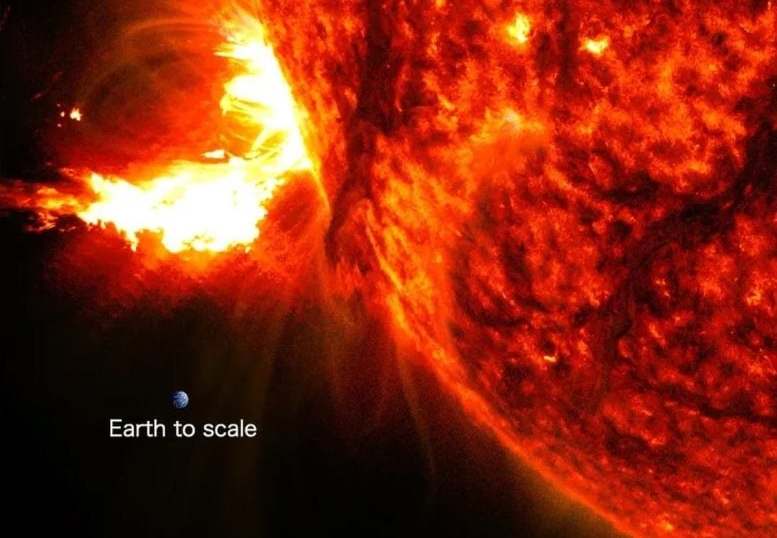NASA Captures Intense X-Class Solar Flares: Sun's Fury

The Solar Dynamics Observatory of NASA took a snapshot of a solar flare, depicted as a brilliant flash on the Sun's edge, on May 27, 2024. An inset image of the Earth has been included for comparison. The photo presents a portion of extreme ultraviolet light which spotlights the extraordinarily heated material in flares, colorized in red for clarity. Credit: NASA/SDO
The Solar Dynamics Observatory (SDO) from NASA, which uniformly tracks the Sun, recently captured photos of two potent X-class solar flares. The premier flare was classified as X2.8 and reached its peak at 3:08 a.m. ET on May 27, 2024. The subsequent flare, labeled as an X1.4, hit its climax at 10:37 a.m. ET on May 29, 2024.
Solar flares are robust explosions of radiation that occur on the Sun, resulting from magnetic energy, which has gathered in the solar atmosphere, suddenly getting released. They emit energy all through the electromagnetic spectrum, ranging from radio waves to gamma rays. Such flares, which can last from minutes to hours, are often followed by coronal mass ejections (CMEs) or the expulsion of solar material.
On May 29, 2024, the Solar Dynamics Observatory of NASA captured this image of a solar flare appearing as a bright flash on the left. The photo presents a portion of extreme ultraviolet light that spotlights the extraordinarily hot material in flares, and is colorized in orange. Credit: NASA/SDO
The intensity of solar flares is categorized based on their brilliance in X-ray wavelengths as observed by satellites, for example, the GOES spacecraft. These categories are labeled as A, B, C, M, or X, with A being the faintest and X the most intense. Each category symbolizes a tenfold surge in energy output, and within every category, a detailed scale ranging from 1 to 9 is utilized. For instance:
A flare's categorization, like X2.8, signifies an X-class flare with a brightness intensity of 2.8 on the logarithmic scale deployed for gauging X-rays. This scale is essential in perceiving and projecting the feasible impacts of solar flares on Earth's space environment and the diverse technologies and systems that can be impacted due to elevated solar radiation levels.
This animated representation of the Solar Dynamics Observatory illustrates it positioned above the Earth, facing the Sun. The SDO is designed to aid us in comprehending the Sun’s influence on Earth and near-Earth space, by studying the solar atmosphere on small space and time scales and across multiple wavelengths at once. Credit: NASA/Goddard Space Flight Center Conceptual Image Lab
The Solar Dynamics Observatory (SDO) from NASA is a mission committed to grasping the Sun’s influence on Earth and its near-Earth surroundings. The SDO, launched on February 11, 2010, as part of NASA’s Living With a Star (LWS) program, focuses on studying facets of the interconnected Sun-Earth system that directly impact life and society.
SDO's main objectives include comprehending the Sun’s atmosphere and its magnetic field, understanding how energy is amassed and unleashed in the solar atmosphere (like in solar flares and coronal mass ejections), and measuring the solar variations that affect Earth's existence and its technological systems. The observatory plays a crucial part in enhancing space weather event forecasts by providing nearly continuous, high-resolution observations of the Sun in multiple wavelengths.
The observatory is fitted with three highly sensitive tools:
The data provided by the SDO are critical for our understanding of the Sun’s complex and dynamic behavior and have significantly improved space weather forecasting.




